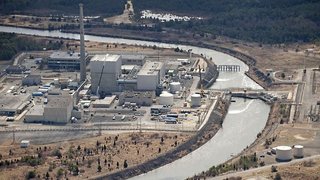
Guests
- Arnie Gundersenformer nuclear industry senior vice president who has coordinated projects at 70 nuclear power plants around the country. He provides independent testimony on nuclear and radiation issues to the NRC, congressional and state legislatures, and government agencies and officials in the U.S. and abroad. He is the chief engineer at Fairewinds Associates and co-author of the Greenpeace report, “Lessons from Fukushima.”
We get an update from Arnie Gundersen, a former nuclear industry senior vice president who has coordinated projects at 70 nuclear power plants around the country, about safety conditions at Oyster Creek and Indian Point nuclear power plants. He says Oyster Creek was close to where the center of the storm crossed into New Jersey, and was forced to declare an emergency when the storm’s tidal surge came within six inches of flooding water pumps that cool its reactor. Gundersen says many of the plants have old designs that need to be re-evaluated, and could shut down in the coming days as electrical grids see power outages. [includes rush transcript]
Transcript
AMY GOODMAN: I want to go, before we go to you, Hans Ehrbar, to Arnie Gundersen. I believe we have him on the phone in Vermont. Arnie Gundersen is—has long worked in the nuclear industry and has very much become a whistleblower around the nuclear industry, former nuclear industry senior vice president who’s coordinated projects at 70 nuclear power plants around the country, providing independent testimony on nuclear and radiation issues to the NRC, the Nuclear Regulatory Commission, congressional and state legislatures and government agencies and officials in the U.S. and abroad. He’s now chief engineer at Fairewinds Associates and co-author of the Greenpeace report, “Lessons from Fukushima.”
Arnie, it’s good to have you back again. We were speaking to you yesterday. Talk about the state of the nuclear power plants along the East Coast as you understand them today.
ARNIE GUNDERSEN: So, yeah, thank you for having me back. It’s always a bad sign when I’m back for a second time in a case like this. The worst plant is the plant that we singled out yesterday on Democracy Now!, which is Oyster Creek. Oyster Creek was very close to where the eye of the hurricane crossed into New Jersey, and initially it lost all of its emergency sirens, which isn’t unexpected in the event of all this wind. But then, afterward, it actually had to declare an emergency because the tidal surge was very high. It was—they were within six inches of flooding the pumps that cool the nuclear reactor. Those are called service water pumps, and they’re right out on Barnegat Bay. So they had to declare an emergency, and they had no sirens to announce an emergency if the situation had gotten worse.
Several other plants have shut down—Indian Point, Nine Mile Point, another one down in New Jersey, Salem. And, of course, reports are still coming in. The ones that shut down did go to their diesels to cool. Of course, the problem is that Salem and the Oyster Creek plant, which we just talked about, were in a refueling mode. And what that means is that all of the nuclear fuel is not in the nuclear reactor, it’s in the spent fuel pool. And when you lose off-site power, you can’t cool the fuel pool. So I suspect in the next couple days we’re going to see reports of, you know, the fuel pools heating up, as—because they were unable to cool the spent fuel pool.
AMY GOODMAN: What are you most concerned about now? I mean, the hurricane has been downgraded to, what, a post-tropical storm. But what about these nuclear plants? And how—for example, Indian Point had to close, I understand, because—around 10:45 last night, because of external electrical grid issues, according to Entergy Corporation, which operates the plant.
ARNIE GUNDERSEN: I think we’ll continue to see power outages, not local power outages where a city goes down, but where the grid goes down. When that happens, a power plant has to shut down. So, for the next day or so, we’ll see grid disruptions that will cause nuclear plants to shut down. That’s what happened at Indian Point. And when the grid shuts down, that’s called loss of the—of off-site power. And the diesels turn on and provide the power to the plant to keep it cool while the grid is down. So, hopefully, the—when these plants lose their power over the next couple of days, we’ll see the diesels turn on. And it’s likely, but not for sure, the diesels will turn on.
The biggest other concern, though, is flooding. Just like at Oyster Creek, all of these plants have to be cooled by a river or a lake, and if the water gets too high in that river or lake, the pumps that cool the plant will be flooded. And that’s called the loss of the ultimate heat sink. The key word there is “ultimate.” The—as happened at Oyster Creek. And I think we’ll likely see, you know, severe flooding in Pennsylvania and inland areas for the next couple days. So we have to watch flooding so that the intake structures to these plants are still able to cool the nuclear reactor and the diesels that cool the plant. Those are the two big concerns: high wind and flooding.
AMY GOODMAN: And nuclear power plants getting older and older, Arnie Gundersen?
ARNIE GUNDERSEN: Yeah. You know, this is the—we call this a “design-bases event.” The plant—no one ever thought that Oyster Creek would see seven feet of flooding to the point where their service order pumps were in jeopardy. So, you know, this issue of global warming is important, because we’ve got conditions now where what we thought was the worst Mother Nature can throw at us, in fact, she had. You know, the Oyster Creek event was like a one-in-a-thousand-year kind of a flood, and it happened. So if these design-bases events are occurring, we need to re-evaluate these older plants and say, “Oh, my god. We could have a more significant design-basis event than we ever imagined.” And we need to re-evaluate whether these plants could withstand it.
AMY GOODMAN: Well, Arnie Gundersen, a nuclear expert, I want to thank you very much for being with us.
ARNIE GUNDERSEN: Thank you.












Media Options